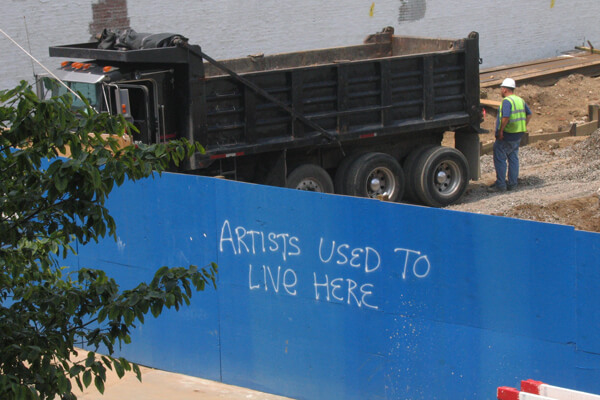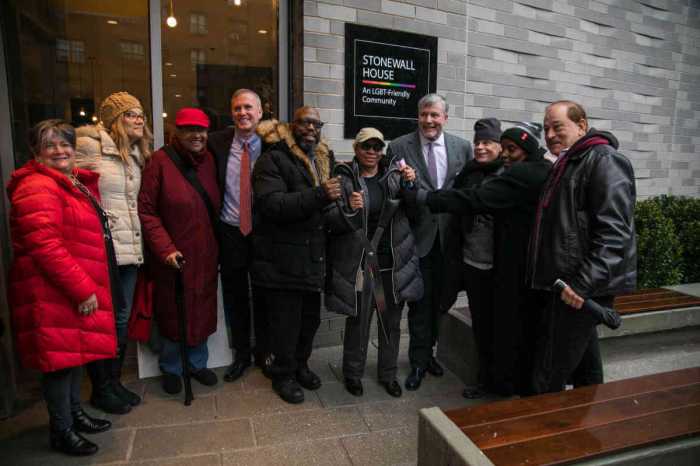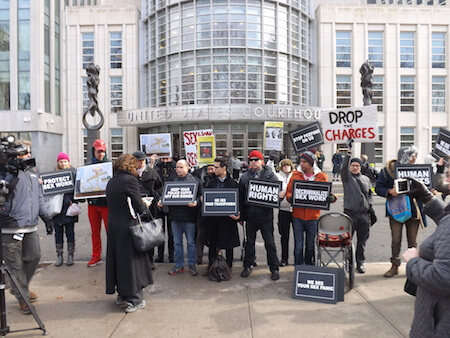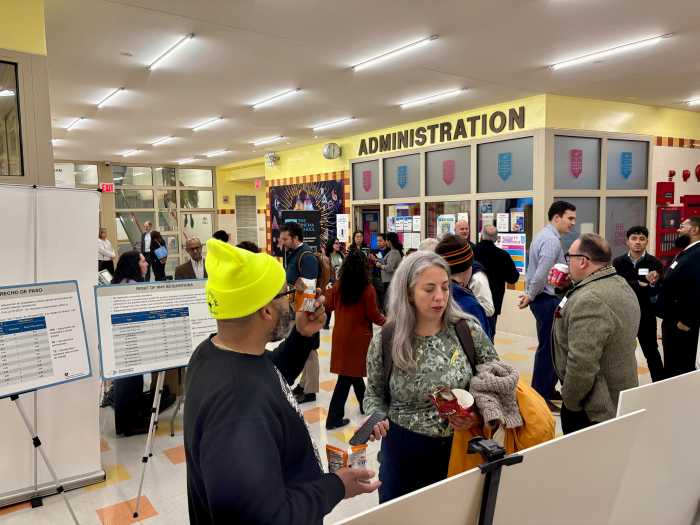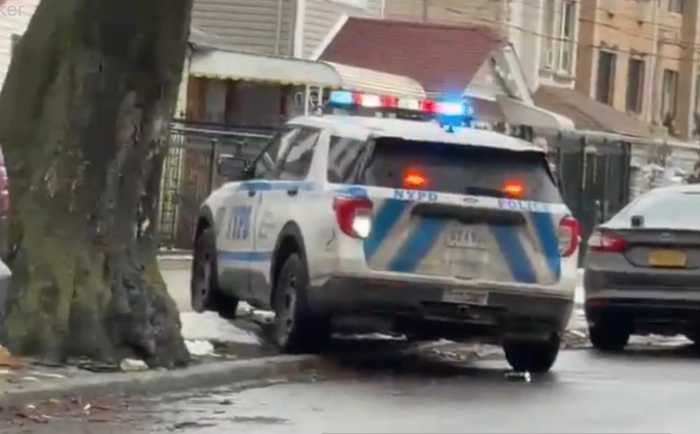Filmmaker Su Friedrich. | DAVID GODLIS
Su Friedrich pulled up to the corner of North Ninth and Berry in Williamsburg in her Volvo on a recent cold Saturday morning to discuss her engaging, enraging new documentary, “Gut Renovation.” The film chronicles how a rezoning law forced artists in her Brooklyn neighborhood — including herself and partner Cathy Quinlan — to move from the commercial spaces where they were living (albeit illegally) so greedy developers could build shiny new condos.
Driving up Kent Avenue, past the old Domino Sugar plant that stretches several blocks along the river, she pointed to a two-story building covered in streaks of paint at Kent and Metropolitan.
“Thirty-one kids lived on the top floor,” Friedrich remarked. “We had a friend who ran it. It was typical of the really funky places people lived.”
There was a hint of nostalgia in her raspy, cigarette-strained voice.
Lesbian filmmaker contemplates her place in a vanishing neighborhood
She continued driving down Kent toward a large, stately building designed by Cass Gilbert. She identified where there once was a huge empty lot between that ran from North Sixth to North 11th. Friedrich recalled shooting a scene there for her film “Hide and Seek.”
“That was one thing about Williamsburg,” she said. “It was a little bit the place where time forgot. There were huge pockets of it where you could just disappear. That was a magical thing about it.”
But her mood soured at the sight of the modern condominium at 49 North Eighth Street.
Turing and passing 80 Wythe Avenue, a corner building Friedrich showcases in “Gut Renovation,” the filmmaker mourned the fact that this former garment factory is now the swanky Wythe Hotel.
“I was invited by a former housemate of ours to come over to the hotel when she was staying there on business, but I couldn’t bear going in,” she said. “It was just so sad.”
Friedrich's graffiti points up the irony of marketing the artsiness of Williamsburg. | OUTCAST FILMS
Her film is filled with personal landmarks that became landfill to make way for modern redesign.
We don’t see the old Williamsburg of the 1980s. Friedrich started shooting “Gut Renovation” in 2005 after the rezoning was announced. With construction taking place across the street from her loft, the film’s soundtrack is peppered with the noise of jackhammers and other drills. She edited the documentary off and on between 2008 and 2012, as she and Quinlan moved to a new place in Bedford-Stuyvesant.
On this cold January day, she parked outside her old building at 118 North 11th Street, to finish discussing “Gut Renovation” at the scene of the “crime.”
Friedrich said her film is not a social activist documentary nor is it is a “city symphony.” Instead, she classified it in the genre of “essay” films like Agnes Varda’s “The Gleaners and I” — films, she explained, that “contemplate an environment, a phenomenon, where you see your place in it. You have a sense of history and politics, and hopefully it would open up a discussion about it. This is what happened, and what we should do next time.”
As she shows in her film, Friedrich and Quinlan paid taxes and helped create a sense of community and safety in Williamsburg for 20 years. Although she lived illegally in commercial space, the city turned a blind eye. Her outrage stems not from the fact she was evicted, but, she insisted, because “there is this incredible blindness about other populations who need a place to live. If they said we had to leave so that a small industry could return to the building and be charged a rent they could afford, then I would say they are right. But if they say, ‘Get out of here so we can rent it to some Wall Street guy paying ten times as much as you,’ then their argument about illegal loft living is a total sham.”
Elaborating, she explained, “It was extremely profitable for the developers and the city to let people live and work in buildings zoned for industry — it was raising the real estate value. It was a secret handshake deal with the city because it benefits them. The reason they came in was because they could make more money.”
Friedrich’s film aims to call attention to what she adamantly, angrily termed, “the will of the local government and the people with money to impose their will on local communities to decide their fate through manipulation and oppression.”
The filmmaker did not make her documentary to engender sympathy for her plight, she said, but rather to open up discussion about class divisions. In making the film, what shocked her most were the violent reactions she heard when she asked people what they thought of artists. A sequence during the closing credits shows the contempt many have for individuals who make art.
“I never thought we [artists] were that highly respected — we’re usually a laughingstock — but in New York, you think people understand that it’s a city that has housed artists and depended on artists for its reputation and income. So I thought there was a grudging respect for artists.”
Adding insult to injury, in Friedrich’s view, was the clever and unintentionally ironic marketing used to attract new residents that played on the idea of Williamsburg being filled with artists.
“They didn’t mention the fact that those artists will be gone!” she exclaimed, snickering at the phrase “Authentic Loft Rentals” on the side of a nearby building. She noted that the lofts are hardly “authentic.”
“They spent a lot of money and time thinking about how to sugarcoat the former condition of the neighborhood to extract what would be attractive to these new people — creative people lived here,” she said. “It was authentic, exciting. When I read these brochures, I would laugh at them, but then I’d see that they were doing things to get people to move in who would never live in Williamsburg the way it was before. So we were just a concept to them.”
If Friedrich’s outrage is palpable in person, it comes across clearly and cogently in the film. She often presents her “crazy anger” and self-deprecating moments in “Gut Renovation.” New residents and real estate developers are irritated as she aims her camera at them on the street — and when she graffitis “Artists Used to Live Here” on the wall of a construction site. She even steals a bottle of wine from an open house and mocks the fancy dogs and nannies taking over the neighborhood. A terrific sequence features the filmmaker amused as construction workers across the street from her loft are frustrated by the challenge of breaking down a giant boulder.
Ultimately, of course, the developers won, and Friedrich had to move. Still, she remains hopeful.
“I think over time, I will become embedded in Bedford-Stuyvesant and love it the way I love Williamsburg,” she said. “But I’ve only been there three years, so it can’t be the same. It’s not like I chose it, it was chosen for me.”
GUT RENOVATION | Directed by Su Friedrich | Outcast Films | Opens Mar. 6 | Film Forum, 209 W. Houston St. | Filmforum.org

